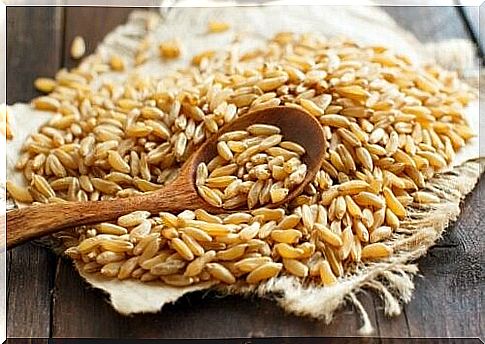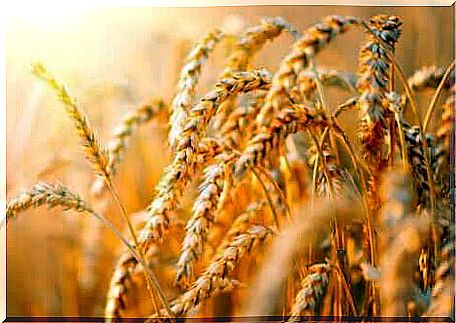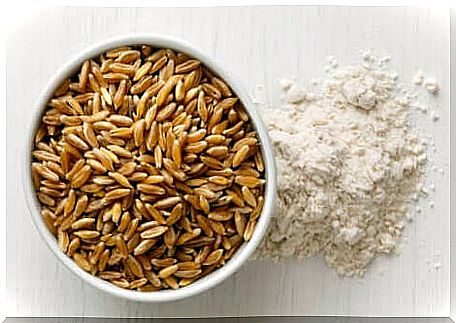Kamut: What Is It And What Properties Does It Offer?

Kamut, a cereal grown in Africa for many years, is gradually becoming part of our diet. It has numerous health benefits and contains several nutrients. It is therefore a very interesting option that can replace wheat.
It should be noted that the position of experts regarding the consumption of a large part of cereals has changed in recent years. Some foods such as wheat are no longer considered to be of good quality due to their high degree of refinement. In their place, whole grain varieties with no added sugar are gaining ground, including kamut.
Differences between kamut and common wheat
Kamut and wheat can be the basic ingredient of pasta and bread. Nevertheless, the differences are remarkable: the former is a cereal with a larger grain, even if it is easier to digest.
One of the main differences is that kamut has a higher protein content, coming to contain about 15 grams of protein per pound of product. It must be remembered that proteins are essential because they guarantee good muscle health, as stated by research published in the journal Nutrients .
At the same time, kamut contains a greater amount of vitamins, among which vitamin A stands out. This substance has a positive effect on eye health, reducing the risk of developing macular diseases.
Regarding the intake of carbohydrates, wheat and kamut have no significant differences, apart from the fact that kamut has a lower glycemic index. It should be borne in mind that we typically consume very refined grain, which is not good for blood glucose levels.

Nutritional properties of kamut
Let’s review the properties of kamut when consumed in a healthy and varied diet.
Provides quality energy
Carbohydrates are an essential element, especially in the diet of people who play sports. They provide the energy needed to activate anaerobic metabolism, a function that makes it possible to perform intense efforts.
For sedentary people, however, the need for carbohydrates is reduced. Even so, they can be introduced into the diet without any health disadvantages. For this purpose, it is necessary to understand what quantities are needed and to prefer carbohydrates with a low glycemic index.
Improve gut health
Kamut is known for its high fiber content, which is essential for intestinal health. It prevents constipation and reduces the risk of developing colon cancer, according to an article published in the International Journal of Food Sciences and Nutrition .
Remember that it is important to include soluble and insoluble fiber in the diet. Kamut is an excellent source of insoluble fiber, so it optimally complements the consumption of cereals that contain beta-glucans, such as oats.
It is antioxidant
The antioxidant properties of kamut come from its vitamin A content. As anticipated, this vitamin protects vision health, but also helps fight inflammatory states and the formation of free radicals.
A good intake of vitamin A is associated with a lower risk of developing liver disease. This is what an article published in Nutrition and Health states .
Helps to keep cholesterol under control
Although it has been said on other occasions that diet has a limited influence on serum cholesterol levels, it is true that fiber can modify the lipid profile. Kamut lowers overall cholesterol levels, albeit not decisively.
However, keeping cholesterol too low is also not good for our health. The myth that the lipid profile alone is a reliable indicator of cardiovascular disease is beginning to be disproved, unless lipoprotein levels are extremely high.
Enhance the Immune System
Among the micronutrients offered by kamut, a special mention goes to zinc. This element regulates the production of testosterone in men and is the basis for the proper functioning of the immune system. Ensuring adequate zinc intake in the diet reduces the risk of infectious diseases.
In addition to its benefits, it must be taken into account that kamut, like wheat, contains gluten, so it is not suitable for celiac people. However, it is not advisable to completely eliminate gluten from the diet, except in the presence of a diagnosis and a prescription from the specialist.

How to cook kamut?
Kamut can be cooked like any other cereal, that is, it must be cooked in water. After washing it, we can cook it in a saucepan or pan.
Once cooked according to the directions on the package, the kamut grains will be tender and ready to be used as a side dish or main ingredient.
You can also buy kamut flour and make homemade pasta and bread. Recipes involving this ingredient require a little more attention due to its different fermentation characteristics.
Kamut: an increasingly popular cereal
Thanks to its nutritional properties, kamut is conquering space on our tables. Regular consumption offers several health benefits and is preferable to the consumption of much more refined wheat.
It is also a simple product to prepare. It can go well with almost any protein food, such as rice or quinoa. In addition to marrying well with vegetables. We advise you to try it and start consuming it on a regular basis.









